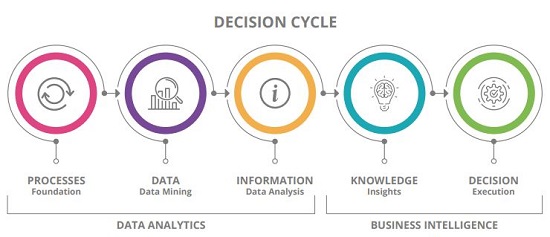The decision cycle will help you make knowledgeable decisions that drive results for your organization. You can use this process when making important forecasting and planning decisions.
 What is the decision cycle, and why is it important?
What is the decision cycle, and why is it important?
The decision cycle was a framework I built during my public accounting time at EY. I realized processes are the foundation of data-driven decision making. It’s a simple process to follow when establishing a data-driven environment and culture to build a solid foundation for operational excellence.
Data is the most valuable currency in the world; having a framework to implement and leverage knowledge sharing, data analysis and insights is the future path to sustainable competitive advantages. Harnessing data for actionable insights to guide strategy and tactical operations is where future accounting and finance teams will have significant business impact and value production. The key elements of the decision cycle follow to help you begin leveraging this framework.
Processes (Foundation)
The most significant element for this framework is processes. Processes are vital to any company as they identify the core steps needed to produce data.
Strong documentation, process mapping and engaged process owners are the foundation of sound business decisions. For example, process templates can be incorporated for department managers so they have a clear understanding of how to document their main processes. Additionally, it makes data collection much easier to proceed to the second stage of the decision cycle. Establishing roles and responsibilities among your staff, as well as actively sharing information throughout the organization, are beneficial in building a high-performance team.
Do you currently utilize process templates? Do your employees know their roles within the organization? Are your organization’s strategic goals communicated and understood by all members of your team? Ask yourself these questions, and make sure you are implementing the processes necessary to optimize communication.
Data (Data Mining)
The raw output of processes is data. Data are the tangible pieces of information derived from processes. When evaluating data, you must ensure the numbers are accurate. You will build comfort and confidence in accuracy by having well thought out processes and consistency in execution. Once collected, you can begin to turn your data into information, thus laying the strategic groundwork you and your team need to make educated business decisions.
Information (Data Analysis)
As soon as data is collected, you can proceed to the information stage of the cycle. In this stage, data will be consolidated to begin the most important element in the decision cycle: data analysis.
Analysis, analysis, and yes, more analysis is vital because this is where high value-added activities are established (i.e. variance analysis, trending, segment, and drill down analyses are performed). Anyone can gather data but turning that data into manageable and clear information is paramount to successful decision making.
There are an infinite amount of ways to analyze data. For example, by analyzing trends of financial data, you could take a deep dive and explore answers to the following questions:
- Is one customer yielding more revenue than another?
- How do our actuals compare to budget and forecast?
Knowledge (Insights)
Once data has been collected and transformed into information, you can turn that information into knowledge. This knowledge can, and should be, shared with colleagues, managers and executives.
The knowledge stage is specifically where organizations realize the true value of the cycle: they are empowered to make future decisions, which are based on concrete information derived from data executed by process owners. Knowledge is power, and it creates an environment where people are empowered to execute data-driven decision making.
Decision (Execution)
The last step in the decision cycle is actually making the decision and executing. If all the subsequent steps have been successfully executed, anyone can make or contribute to the final decision—not just the executive team.
It’s important to understand that as a result of the prior steps, both comfort and confidence are built to ensure a sound final decision is made. Therefore, execution is a comprehensive effort by all because of the many touchpoints the information traveled throughout the cycle.